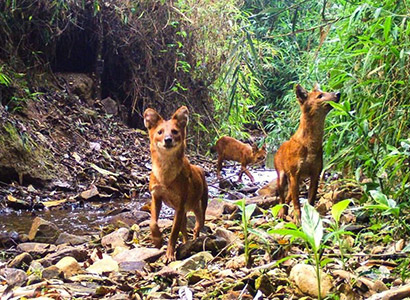Laos’ National Day for Wildlife Conservation Shows its Dedication to Animals
Source: Vientiane Times
Abundant natural resources are essential to the stability of the planet because all living things, including humans, animals, and vegetation, are dependent on each other.
Laos is rich in natural resources and biodiversity, and in 1997 the government designated July 13 as National Day for Wildlife and Aquatic Animal Conservation, which coincides with the birthday of Laos’ first President, Souphanouvong.
Every year on this day, the government and other entities organize activities to raise awareness among young people and the whole of society about the importance of conserving aquatic species and other forms of wildlife.
At the same time, the activities are viewed as earning merit for Buddhist organizers and participants, and commemorate the great virtues and achievements of President Souphanouvong.
Deputy Minister of Agriculture and Forestry, Mr. Thongphath Vongmany, told the Vientiane Times that Laos is home to more than one thousand species of wild animals and more than 500 kinds of fish.
However, some of these are on the verge of extinction, such as the saola (Asian unicorn), khayou (rocky mouse), tigers, elephants, brow-antlered deer and other species.
Mr. Thongphath said these animals are important for maintaining the abundance of forest resources and ecological balance, as well as being part of Laos’ precious natural heritage.
The Ministry of Agriculture and Forestry has instructed relevant departments at the central level, local government agencies, and the general public to actively support the conservation and management of wild animals, in ways that are sustainable and contribute to food security, as well as generating income for the people of Laos.
Last year, the ministry partnered with provincial government agencies to organize activities on National Day for Wildlife and Aquatic Animal Conservation, which involved the public, traders, entrepreneurs, and international organizations.
A total of 58.3 million fish fingerlings and other aquatic animals were added to the country’s rivers, while more than 200 birds, reptiles and other animals were released into the wild.
Mr Thongphath said the country’s wildlife is a big tourist draw and naturalists love to spend time on rivers and in forests.
Wildlife conservation is a priority for the government, which recognizes the critical role the animal kingdom plays in the ecosystem.
Conservation will enable animals to thrive and contribute to a healthy environment, and if protected and allowed to reproduce in large numbers will also provide sustenance for people living in remote areas, he added.
However, a huge number of animals are being killed, captured, and traded. In addition, animal populations are rapidly diminishing in size due to habitat loss as people cut down trees and burn forests.
Some people don’t understand the reasons for the worldwide effort to conserve wildlife, or why the wildlife trade is illegal.
But Laos is one of 184 states that are party to the Convention on International Trade in Endangered Species (CITES) – a multilateral treaty to protect endangered plants and animals from the threat of international trade.
This means the government is obliged to ensure compliance with laws relating to the illegal wildlife trade.
Unfortunately, illegal hunting, or poaching, is widespread in Laos and is believed to be a major contributor to the demise of many species. In addition to breaking the law, illegal hunting can be a threat to biodiversity and even cause extinction.
According to Earth & Animal Advocates, in just the past 40 years, nearly 52 percent of the planet’s wildlife species have been eliminated. The leading cause of these shocking declines is irresponsible and unethical human activities.
In addition to the devastating consequences of deforestation, animal agriculture, development, and environmental pollution, the wildlife trade is playing a major role in species extinction.
Mr. Thongphath said the government’s goal is to protect animals from extinction and to strengthen law enforcement in this regard.
Laos has a landmass of 23.68 million hectares, of which 16.5 million hectares are forested, with 81 percent of this area under a protection order.
“We still have many problems with hunting and illegal trading in Laos. This occurs because people don’t understand the law, especially in remote areas, and punishments are not deterrents. Another problem is that illegal wildlife traders in neighboring countries use Laos as a transit country,” Mr. Thongphath said.
On National Day for Wildlife and Aquatic Animal Conservation, Mr. Thongphath urges everyone to band together to protect the country’s natural habitat and the animals that depend on it for survival.
He is confident that, in time, everyone will come to understand the vital reasons why wildlife must be protected and allowed to thrive in our shared environment.


